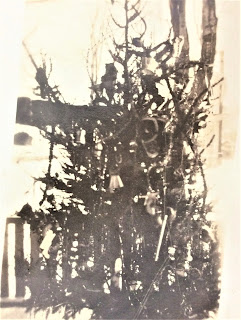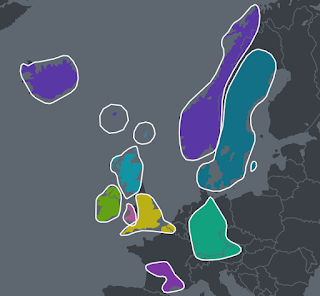I honor my beloved dead, those I knew in this world, and my ancestral dead, those who paved the way for me.
I pour water in the glass cup on my Ancestor Altar. I light a candle in my fossil candle holder. It is the lighthouse guiding their way to me. I light more candles for specific prayers. I take in a breath and as I exhale I open my heart. I open myself to spirit world. I am not the lighthouse.
I am the light.
~~*~~
I open to my Grandparents:
Richard James Riddle & Donna MacDonald, both my beloved dead
*
 |
| With her much-loved cat Bella. |
Patricia Art, my beloved dead
*Mark Dutcher Eaton, my beloved dead, & Ruth Emma Ruston
~*~
I open to my Great-Grandparents:
Harold Riddle & Elsie Elizabeth Durant, my beloved dead*  |
| With daughters Dolores & Biddy. |
Robert Joseph Art & Margaret Loretta Burke*Frank William Ruston & Minnie Estelle Wicker
*
Royal Levant Eaton & Hattie Eva Smith
~*~
I open to my Great-Great-Grandparents:
 |
| Frances & Lafayette are in the center, front. |
Lafayette Riddle & Frances Ann Gillette [NY]
*
George Frances Durant & Emma Louise Burnah [NY]* George Art & Katherine Pils [NY]* Frank Burke & Eliza Conners [NY]
*
 |
| Ruth & Charles are in the center back. |
Charles Evan Ruston & Ruth Ireland [both from England]
*
 |
| Hiram & Emma are the center couple. |
Hiram King Wicker & Emma Angeline Whitcher [NY]
*
Bennett Eaton & Theresa Cordelia Tenney [MI/NY]
*
Silas Parker Smith & Hattie Eva Dutcher [NY]
~*~
I open to my Great-Great-Great-Grandparents:
Marquise DeLafayette Riddle & Sarah Clickner [NY]
*
 |
| Levi & Jane are seated in the second row. |
Levi Gillette & Jane Berry [NY]
*
Albert Durant & Rosella LaValley [both from Quebec]* Samuel Burnah [from Quebec] & Mary (unknown) [NY]
*
Adam Art & Katherine Maria Schmeelk [both from Germany]* John Pils & Mary Burzee [both from Germany]
Thomas Burke & Ellen (unknown) [NY]
David Conners & Mary Dowd [both from Ireland]
Richard Ruston & Anna Richardson [both of England]
William Ireland & Phoebe Lenton [both of England]
Thaddeus Rice Wicker & Cynthia Lusk [VT/NY]
*
Bailey Harrison Whitcher & Ordelia de Lozier [VT/NY]
*
Solomon Gould Eaton & Hannah Ann Treadwell [NY]
Philetus Tenny & Malvina H. Targee [NY]
*
Ammi Smith & Sophia Sears [NY]
*
Reuben Feagles Dutcher & Eliza Marsh Bird [NY/MA]
~*~
I open to my Great-Great-Great-Great Grandparents:
Freeborn Moulton Riddle & Abigail Chaffee [MA/NY]
William Clickner & Mary Ann Hayner [NY]
*
Ezra Wheeler Gillette & Mary Ann Boots [VT/NY] *
Francis Berry & Elizabeth Ann Hill [NY] *
George Durant & Safrona (unknown) [both of Quebec]
Francois Xavier Lavalle & Rosella LaRoche [both of Quebec]
George Arth & Wilhemina Wernersbach [both from Germany]
John Burke & Ann (unknown) [both of Ireland]
(unknown) & Betsy Conners [both of Ireland]
Barney Dowd & Betsey (unknown) [both from Ireland]
Edward Ruston & Jane Brooks [both of England]
Thomas Richardson & Mary (unknown) [both of England]
John Ireland & wife (unknown) [both of England]
John Lenton & Mary Wilson [both of England]
Pliney Wicker & Chloe Morgan [MA]
Elizer Lusk & Rebecca (unknown) [NY]
Simon Whittier & Dorcas Kittredge [MA/VT]
*
Peter DeLozier & Lucy Raymond [CT/NY] *
Joshua Eaton & Lucy Gould [CT/NY]
Solomon P. Treadwell & Fannie (unknown) [NY]
*
Hiram Tenney & Esther or Sally (unknown) [NY] *
Thomas Targee & Ellen (unknown) [RI/NY]
David Smith & Betsy (unknown) [NY]
Heman Sears & Clarissa Debois [CT/NY]
Martin Dutcher & Cynthia Ann Feagles [NY]
Amanly Bird & Irene Pond Marsh [MA/NH]
~~*~~
I open to my ancestors, known and unknown. .jpg)














































